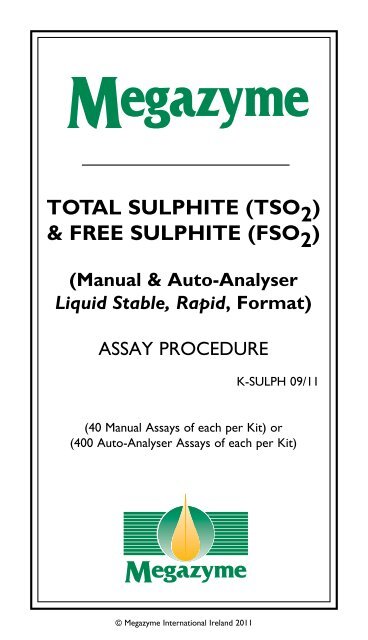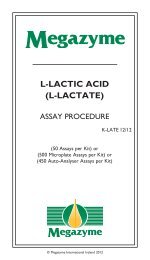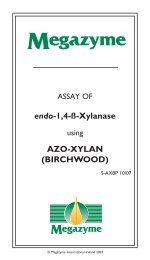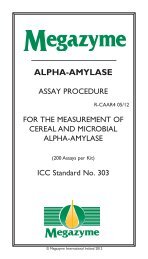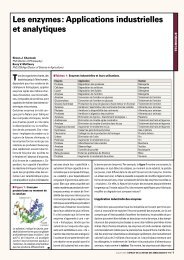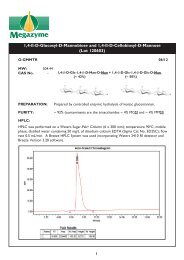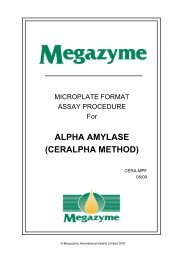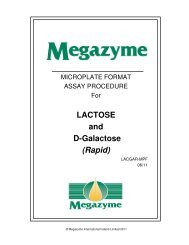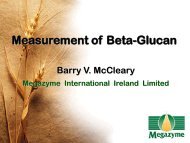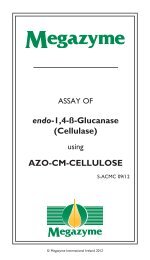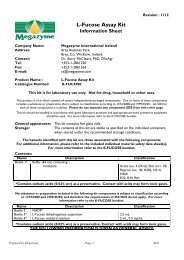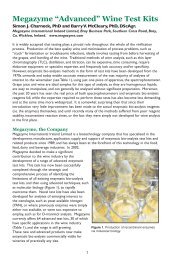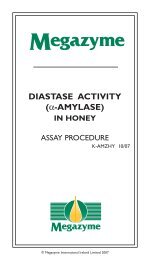TOTAL SULPHITE (TSO2) & FREE SULPHITE (FSO2) - Megazyme
TOTAL SULPHITE (TSO2) & FREE SULPHITE (FSO2) - Megazyme
TOTAL SULPHITE (TSO2) & FREE SULPHITE (FSO2) - Megazyme
You also want an ePaper? Increase the reach of your titles
YUMPU automatically turns print PDFs into web optimized ePapers that Google loves.
<strong>TOTAL</strong> <strong>SULPHITE</strong> (TSO 2 )<br />
& <strong>FREE</strong> <strong>SULPHITE</strong> (FSO 2 )<br />
(Manual & Auto-Analyser<br />
Liquid Stable, Rapid, Format)<br />
ASSAY PROCEDURE<br />
K-SULPH 09/11<br />
(40 Manual Assays of each per Kit) or<br />
(400 Auto-Analyser Assays of each per Kit)<br />
© <strong>Megazyme</strong> International Ireland 2011
CONTENTS:<br />
INTRODUCTION 1<br />
PRINCIPLE 1<br />
SPECIFICITY, SENSITIVITY, LINEARITY AND PRECISION 1<br />
INTERFERENCES 2<br />
SAFETY 3<br />
KITS 3<br />
PREPARATION OF REAGENT SOLUTIONS (SUPPLIED) 3<br />
RECOMMENDED REAGENTS (NOT SUPPLIED) 3<br />
EQUIPMENT (RECOMMENDED) 4<br />
MANUAL ASSAY PROCEDURES 5<br />
A. MANUAL ASSAY PROCEDURE FOR <strong>TOTAL</strong> <strong>SULPHITE</strong> (TSO 2 ) 5<br />
PREPARATION OF THE TSO 2 SINGLE POINT STANDARD 6<br />
CALCULATION OF TSO 2 CONTENT USING A SINGLE POINT TSO 2 STANDARD 6<br />
PREPARATION OF THE TSO 2 CALIBRATION CURVE 7<br />
CALCULATION OF TSO 2 CONTENT USING THE TSO 2 CALIBRATION CURVE 7<br />
B. MANUAL ASSAY PROCEDURE FOR <strong>FREE</strong> <strong>SULPHITE</strong> (FSO 2 ) 10<br />
PREPARATION OF THE FSO 2 SINGLE POINT STANDARD 10<br />
CALCULATION OF FSO 2 CONTENT USING A SINGLE POINT FSO 2 STANDARD 11<br />
PREPARATION OF THE FSO 2 CALIBRATION CURVE 12<br />
CALCULATION OF FSO 2 CONTENT USING THE FSO 2 CALIBRATION CURVE 12<br />
AUTO-ANALYSER ASSAY PROCEDURES 15<br />
A. AUTO-ANALYSER ASSAY PROCEDURE FOR <strong>TOTAL</strong> <strong>SULPHITE</strong> (TSO 2 ) 15<br />
B. AUTO-ANALYSER ASSAY PROCEDURE FOR <strong>FREE</strong> <strong>SULPHITE</strong> (FSO 2 ) 16<br />
MICROPLATE ASSAY PROCEDURES 17<br />
EQUIPMENT (RECOMMENDED) 17<br />
A. MICROPLATE ASSAY PROCEDURE FOR <strong>TOTAL</strong> <strong>SULPHITE</strong> (TSO 2 ) 18<br />
B. MICROPLATE ASSAY PROCEDURE FOR <strong>FREE</strong> <strong>SULPHITE</strong> (FSO 2 ) 19<br />
SAMPLE PREPARATION 19<br />
1. SAMPLE DILUTION 19<br />
2. SAMPLE CLARIFICATION 20<br />
3. GENERAL CONSIDERATIONS 20<br />
SAMPLE PREPARATION EXAMPLES 21<br />
i
INTRODUCTION:<br />
Sulphur dioxide (SO 2 ) is used widely as an additive in various forms,<br />
most commonly as sulphites (or sulfites), in the wine, beverage<br />
and food industries where it acts primarily as an antimicrobial and<br />
antioxidant preservative.<br />
During wine making sulphites are used as an essential additive, usually<br />
at post-malolactic fermentation, in the control of contamination<br />
by Brettanomyces during aging and to also protect the wine against<br />
detrimental “oxidative and enzymatic browning”. SO 2 is only active<br />
as an antimicrobial and antioxidant preservative in the unbound<br />
“free” form. Given that SO 2 becomes “inactive” when it binds the<br />
colour pigments of wine, and with legal restrictions on SO 2 levels in<br />
wine, it has become valuable to wine producers to measure both the<br />
Free SO 2 (FSO 2 ) and Total SO 2 (TSO 2 ). In addition to this, due to<br />
the increased awareness of the adverse effects of sulphites and the<br />
prevalence of sulphite intolerance in some individuals, sulphite levels<br />
in foods and drinks are strictly regulated by various governing bodies<br />
and therefore there is a requirement for accurate determination of<br />
the level of sulphites in foods, beverages and wines.<br />
This kit (K-SULPH) is suitable for the specific measurement of both<br />
“Total Sulphite” and “Free Sulphite” especially in wines, beverages,<br />
foodstuffs and other materials.<br />
PRINCIPLE:<br />
The Total Sulphite assay is based on the reaction principle between<br />
thiol goups and Ellman’s reagent.<br />
The Free Sulphite assay is based on the reaction principle of SO 2 ,<br />
fuchsin and aldehyde binding.<br />
SPECIFICITY, SENSITIVITY, LINEARITY AND<br />
PRECISION:<br />
Total Sulphite (TSO 2 )<br />
Compounds containing free thiols (e.g. cysteine, ß-mercaptoethanol,<br />
dithiothreitol) can react in the TSO 2 assay.<br />
The smallest differentiating absorbance for the assay is 0.010<br />
absorbance units. This corresponds to a TSO 2 concentration of<br />
~ 2.64 mg/L of sample solution at a sample volume of 0.05 mL. The<br />
detection limit is ~ 5.28 mg/L, which is derived from an absorbance<br />
difference of 0.020 with a sample volume of 0.05 mL.<br />
The assay is linear over the range of 0.25 to 20 µg of TSO 2 per<br />
1
assay. With a sample volume of 0.05 mL, this corresponds to a TSO 2<br />
concentration of ~ 5 to 400 mg/L of sample solution. In duplicate<br />
determinations using one sample solution, an absorbance difference<br />
of 0.005 to 0.010 may occur. With a sample volume of 0.05 mL, this<br />
corresponds to a TSO 2 concentration of ~ 1.32 to ~ 2.64 mg/L of<br />
sample solution. If the sample is diluted during sample preparation,<br />
the result is multiplied by the dilution factor, F. If, in sample<br />
preparation, the sample is weighed, e.g. 10 g/L, a difference of 0.02 to<br />
0.05 g/100 g can be expected.<br />
Free Sulphite (FSO 2 )<br />
The smallest differentiating absorbance for the assay is 0.010<br />
absorbance units. This corresponds to a FSO 2 concentration of<br />
~ 1 mg/L of sample solution at a sample volume of 0.05 mL. The<br />
detection limit is ~ 2 mg/L, which is derived from an absorbance<br />
difference of 0.020 with a sample volume of 0.05 mL.<br />
The assay is linear over the range of 0.25 to 7.5 µg of FSO 2 per<br />
assay. With a sample volume of 0.05 mL, this corresponds to a FSO 2<br />
concentration of ~ 5 to 150 mg/L of sample solution. In duplicate<br />
determinations using one sample solution, an absorbance difference<br />
of 0.005 to 0.010 may occur. With a sample volume of 0.05 mL, this<br />
corresponds to a FSO 2 concentration of ~ 0.5 to ~ 1 mg/L of sample<br />
solution. If the sample is diluted during sample preparation, the result<br />
is multiplied by the dilution factor, F. If, in sample preparation, the<br />
sample is weighed, e.g. 10 g/L, a difference of 0.02 to 0.05 g/100 g can<br />
be expected.<br />
INTERFERENCES:<br />
Total Sulphite (TSO 2 )<br />
Compounds containing free thiols (e.g. cysteine, ß-mercaptoethanol,<br />
dithiothreitol) or thiol reactive compounds (e.g. aldehydes, maleimide<br />
compounds) can interfere with TSO 2 assay.<br />
Aldehyde levels in wines will not cause interference of the TSO 2<br />
assay.<br />
Free Sulphite (FSO 2 )<br />
Thiol reactive compounds (e.g. aldehydes, maleimide compounds) can<br />
interfere with FSO 2 assay.<br />
Endogenous aldehydes in wine are not considered as an interference<br />
for the FSO 2 assay for wine samples.<br />
2
SAFETY:<br />
The reagents used in the determination of sulphites are not<br />
hazardous materials in the sense of the Hazardous Substances<br />
Regulations. However, the buffer concentrates contain sodium azide<br />
(0.05 % w/v) as a preservative. The general safety measures that<br />
apply to all chemical substances should be adhered to.<br />
KITS:<br />
Kits suitable for performing 40 assays of each test in manual format<br />
(or 400 assays of each test in auto-analyser format) are available from<br />
<strong>Megazyme</strong>. The kits contain the full assay method plus:<br />
Bottle 1:<br />
Bottle 2:<br />
Bottle 3:<br />
Bottle 4:<br />
Bottle 5:<br />
Total Sulphite Reagent 1 (40 mL)<br />
Contains sodium azide (0.05 % w/v) as a preservative.<br />
Stable for > 18 months at room temperature.<br />
Total Sulphite Reagent 2 (20 mL)<br />
Contains sodium azide (0.05 % w/v) as a preservative.<br />
Stable for > 18 months at room temperature.<br />
Free Sulphite Reagent 1 (40 mL)<br />
Stable for > 18 months at room temperature.<br />
Free Sulphite Reagent 2 (20 mL)<br />
Stable for > 18 months at room temperature.<br />
Sulphite Standard<br />
Sodium Sulphite (5 g).<br />
Stable for > 5 years at room temperature.<br />
PREPARATION OF REAGENT SOLUTIONS (SUPPLIED):<br />
1-4. Use the contents of bottles 1 to 4 as supplied.<br />
5. Use the contents of bottle 5 as described for the preparation<br />
of TSO 2 and FSO 2 standards and calibration curves.<br />
RECOMMENDED REAGENTS (NOT SUPPLIED):<br />
1. Citric acid (FLUKA cat no. 251275).<br />
2. Sodium Sulphite (SIGMA cat no. 71989).<br />
3
EQUIPMENT (RECOMMENDED):<br />
1. Disposable plastic cuvettes (1 cm light path, 3 mL).<br />
2. Micro-pipettors, e.g. Gilson Pipetman ® (200 µL and 1 mL).<br />
3. Positive displacement pipettor e.g. Eppendorf Multipette ®<br />
- with 25 mL Combitip ® [to dispense 0.5 mL and 1 mL aliquots<br />
of reagent solutions (solutions 1-4)].<br />
4. Stop clock.<br />
5. Analytical balance.<br />
6. Spectrophotometer set at 405 nm and 575 nm.<br />
7. Vortex mixer (e.g. IKA ® Yellowline Test Tube Shaker TTS2).<br />
8. Whatman No. 1 (9 cm) filter papers.<br />
4
MANUAL ASSAY PROCEDURES:<br />
NOTES:<br />
1. The Manual Assay Procedure for TSO 2 or FSO 2 must be<br />
performed using either a single point standard or a full<br />
calibration curve.<br />
2. For each batch of samples that are applied to the determination<br />
of TSO 2 or FSO 2 either a single point standard or a<br />
calibration curve must be performed concurrently using<br />
the same batch of reagents.<br />
3. Prepare the TSO 2 or FSO 2 standards for the single point<br />
standard or full calibration curve as described for the Manual<br />
Assay Procedures for TSO 2 or FSO 2 , respectively.<br />
4. The calculation of TSO 2 or FSO 2 content, including the<br />
calibration curve analysis, can be simplified by using the<br />
<strong>Megazyme</strong> Mega-Calc, downloadable from where the<br />
product appears on the <strong>Megazyme</strong> website (www.megazyme.<br />
com).<br />
A. MANUAL ASSAY PROCEDURE FOR <strong>TOTAL</strong><br />
<strong>SULPHITE</strong> (TSO 2 ):<br />
Wavelength: 405 nm<br />
Cuvette: 1 cm light path (glass or plastic)<br />
Temperature: ~ 25°C<br />
Final volume: 2.55 mL<br />
Sample solution: 0.25-20 µg of SO 2 per cuvette (5-400 mg/L)<br />
(in 0.05 mL sample volume)<br />
Read against air (without cuvette in the light path) or against water<br />
Pipette into cuvettes Sample Standard Blank<br />
distilled water (at ~ 25°C)<br />
Total Sulphite Reagent 1<br />
sample<br />
standard<br />
1.00 mL<br />
1.00 mL<br />
0.05 mL<br />
-<br />
1.00 mL<br />
1.00 mL<br />
-<br />
0.05 mL<br />
1.05 mL<br />
1.00 mL<br />
-<br />
-<br />
Mix*, read absorbances of the solutions (A 1 ) after exactly 3 min.<br />
Then add:<br />
Total Sulphite Reagent 2 0.50 mL 0.50 mL 0.50 mL<br />
Mix*, read absorbances of the solutions (A 2 ) after exactly 3 min.<br />
* for example with a plastic spatula or by gentle inversion after sealing<br />
the cuvette with a cuvette cap or Parafilm ® .<br />
5
PREPARATION OF THE TSO 2 SINGLE POINT<br />
STANDARD:<br />
The TSO 2 standard is required for the calculation of TSO 2<br />
in the test samples.<br />
Weigh 1 g of citric acid into a 1 L volumetric flask, make to 1 L<br />
with distilled water and dissolve. Accurately add 590 mg of sodium<br />
sulphite and dissolve. This is the 300 mg/L standard, use this<br />
directly as the single point standard in the Manual Assay<br />
Procedure For Total Sulphite (TSO 2 ). Prepare on the day of<br />
use. Stable for 1 day at room temperature.<br />
NOTE: Alternatively, a full TSO 2 calibration curve can be used and<br />
the TSO 2 content calculated as described for “Preparation of the<br />
TSO 2 Calibration Curve”.<br />
CALCULATION OF TSO 2 CONTENT USING A SINGLE<br />
POINT STANDARD:<br />
Determine the ∆A TotalSO2 for the sample, standard and blank.<br />
Subtract the ∆A TotalSO2 of the blank from that of the sample and<br />
the standard, thereby obtaining ∆A TotalSO2-SAMPLE and ∆A TotalSO2-STD ,<br />
respectively.<br />
The value of ∆A TotalSO2-SAMPLE and ∆A TotalSO2-STD should be at least<br />
0.100 absorbance units to achieve sufficiently accurate results.<br />
The concentration of TSO 2 can be calculated as follows:<br />
∆A TotalSO2 = A 2 - (A 1 x 2050 / 2550)<br />
c = ∆A TotalSO2-SAMPLE x F [mg/L]<br />
∆A TotalSO2-STD / c TotalSO2-STD<br />
where:<br />
c TotalSO2-STD = concentration of TSO 2 standard (mg/L)<br />
F<br />
= dilution factor<br />
If the sample is diluted during preparation, the result must be<br />
multiplied by the dilution factor, F.<br />
When analysing solid and semi-solid samples which are weighed out<br />
for sample preparation, the content (g/100 g) is calculated from the<br />
amount weighed as follows:<br />
Content of TSO 2<br />
= c TotalSO2 [g/L sample solution] x 100 [g/100 g]<br />
weight sample [g/L sample solution]<br />
NOTE: These calculations can be simplified by using the <strong>Megazyme</strong><br />
Mega-Calc, downloadable from where the product appears on<br />
the <strong>Megazyme</strong> website (www.megazyme.com).<br />
6
PREPARATION OF THE TSO 2 CALIBRATION CURVE:<br />
Weigh 1 g of citric acid into a 1 L volumetric flask, make to 1 L<br />
with distilled water and dissolve. Accurately add 787 mg of sodium<br />
sulphite and dissolve. This is the 400 mg/L TSO 2 solution.<br />
Prepare on the day of use. Stable for 1 day at room<br />
temperature.<br />
Prepare the TSO 2 standard solutions as described in the table below<br />
and use directly as standards to determine A 2 in the Manual Assay<br />
Procedure For Total Sulphite (TSO 2 ).<br />
CALCULATION OF TSO 2 CONTENT USING THE TSO 2<br />
CALIBRATION CURVE:<br />
1. TSO 2 CALIBRATION CURVE ANALYSIS:<br />
1. Determine the absorbance (A 2 ) of each TSO 2 standard (STD<br />
0 - 5). Subtract the absorbance of STD 0 from the absorbance of<br />
the other standards (STD 1 - 5), thereby obtaining ∆A TotalSO2 (An<br />
example is given in Table 1).<br />
Pipette into 13 mL<br />
polypropylene tubes<br />
STD<br />
0<br />
STD<br />
1<br />
STD<br />
2<br />
STD<br />
3<br />
STD<br />
4<br />
STD<br />
5<br />
(TSO 2 ) mg/L 0 40 80 160 320 400<br />
0.1 % (w/v) citric acid (mL) 5.00 4.50 4.00 3.00 1.00 -<br />
TSO 2 solution (mL) - 0.50 1.00 2.00 4.00 5.00<br />
Total Volume (mL) 5.00 5.00 5.00 5.00 5.00 5.00<br />
2. Calculate M as follows, for each standard (STD 1 - 5):<br />
M = TSO 2 (mg/L) [(mg/L)/∆A TotalSO2 ]<br />
∆A TotalSO2<br />
3. Calculate the mean M as follows:<br />
mean M = (M STD1 + M STD2 + M STD3 + M STD4 + M STD5 ) [(mg/L)/∆A TotalSO2 ]<br />
5<br />
Use “mean M” to calculate the TSO 2 content of the test<br />
samples in section 2 “Total Sulphite (TSO 2 ) Content”.<br />
7
Example:<br />
Examples of the TSO 2 calibration curve calculations are given in Table<br />
1 along with a graphical representation of a typical TSO 2 calibration<br />
curve (Figure 1).<br />
TSO 2<br />
standard<br />
TSO 2<br />
(mg/L)<br />
A 405 ∆A TotalSO2 [(mg/L)/<br />
M<br />
∆A <strong>TSO2</strong> ]<br />
STD 0 0 0.335 0.000 -<br />
STD 1 25 0.421 0.085 293.083<br />
STD 2 50 0.516 0.181 276.091<br />
STD 3 100 0.717 0.382 261.986<br />
STD 4 300 1.543 1.208 248.365<br />
STD 5 400 1.991 1.656 241.604<br />
mean M - - - 264.226<br />
Table 1. Calculations for a typical TSO 2 calibration curve<br />
<br />
<br />
<br />
<br />
<br />
<br />
<br />
<br />
<br />
<br />
Figure 1. Calibration curve demonstrating the linearity of the<br />
colourimetric TSO 2 determination by K-SULPH. The sulphite<br />
standards were analysed in a cuvette with a 1.0 cm lightpath.<br />
8
2. <strong>TOTAL</strong> <strong>SULPHITE</strong> (TSO 2 ) CONTENT:<br />
Determine the ∆A TotalSO2 for the sample and blank. Subtract the<br />
∆A TotalSO2 of the blank from that of the sample, thereby obtaining<br />
∆A TotalSO2-SAMPLE .<br />
The value of ∆A TotalSO2-SAMPLE should be at least 0.100 absorbance<br />
units to achieve sufficiently accurate results.<br />
The concentration of TSO 2 can be calculated as follows:<br />
∆A TotalSO2 = A 2 - (A 1 x 2050 / 2550)<br />
c<br />
= mean M x F x ∆A TotalSO2-SAMPLE [mg/L]<br />
where:<br />
mean M = mean value of TSO 2 standards [(mg/L)/∆A TotalSO2 ]<br />
F<br />
= dilution factor<br />
If the sample is diluted during preparation, the result must be<br />
multiplied by the dilution factor, F.<br />
When analysing solid and semi-solid samples which are weighed out<br />
for sample preparation, the content (g/100 g) is calculated from the<br />
amount weighed as follows:<br />
Content of TSO 2<br />
= c TotalSO2 [g/L sample solution] x 100 [g/100 g]<br />
weight sample [g/L sample solution]<br />
NOTE: These calculations, including the calibration curve<br />
analysis, can be simplified by using the <strong>Megazyme</strong> Mega-Calc,<br />
downloadable from where the product appears on the <strong>Megazyme</strong><br />
website (www.megazyme.com).<br />
9
B. MANUAL ASSAY PROCEDURE FOR <strong>FREE</strong> <strong>SULPHITE</strong><br />
(FSO 2 ):<br />
Wavelength: 575 nm<br />
Cuvette: 1 cm light path (glass or plastic)<br />
Temperature: ~ 25°C<br />
Final volume: 2.55 mL<br />
Sample solution: 0.25-7.5 µg of SO 2 per cuvette (5-150 mg/L)<br />
(in 0.05 mL sample volume)<br />
Read against air (without cuvette in the light path) or against water<br />
Pipette into cuvettes Sample Standard Blank<br />
distilled water (at ~ 25°C)<br />
Free Sulphite Reagent 1<br />
sample<br />
standard<br />
1.00 mL<br />
1.00 mL<br />
0.05 mL<br />
-<br />
1.00 mL<br />
1.00 mL<br />
-<br />
0.05 mL<br />
* for example with a plastic spatula or by gentle inversion after sealing<br />
the cuvette with a cuvette cap or Parafilm ® .<br />
PREPARATION OF THE FSO 2 SINGLE POINT<br />
STANDARD:<br />
1.05 mL<br />
1.00 mL<br />
-<br />
-<br />
Mix*, read absorbances of the solutions (A 1 ) after exactly 3 min.<br />
Then add:<br />
Free Sulphite Reagent 2 0.50 mL 0.50 mL 0.50 mL<br />
Mix*, read absorbances of the solutions (A 2 ) after exactly 3 min.<br />
Mix*, read absorbances of the solutions (A 3 ) after exactly 3 min.<br />
The FSO 2 standard is required for the calculation of FSO 2 in<br />
the test samples.<br />
Weigh 1 g of citric acid into a 1 L volumetric flask, make to 1 L<br />
with distilled water and dissolve. Accurately add 196 mg of sodium<br />
sulphite and dissolve. This is the 100 mg/L standard, use this<br />
directly as the single point standard in the Manual Assay<br />
Procedure for Free Sulphite (FSO 2 ). Prepare on the day of<br />
use. Stable for 1 day at room temperature.<br />
NOTE: Alternatively, a full FSO 2 calibration curve can be used and<br />
the FSO 2 content calculated as described for “Preparation of the<br />
FSO 2 Calibration Curve”.<br />
10
CALCULATION OF FSO 2 CONTENT USING A SINGLE<br />
POINT STANDARD:<br />
Determine the ∆A FreeSO2 for the sample, standard and blank. Subtract<br />
the ∆A FreeSO2 of the blank from that of the sample and the standard,<br />
thereby obtaining ∆A FreeSO2-SAMPLE and ∆A FreeSO2-STD , respectively.<br />
The value of ∆A FreeSO2-SAMPLE and ∆A FreeSO2-STD should be at least<br />
0.100 absorbance units to achieve sufficiently accurate results.<br />
As the reaction between FSO 2 and the aldehyde proceeds, the<br />
equilibrium reaction between “bound” SO 2 and FSO 2 shifts towards<br />
FSO 2 . With red wine this equilibrium reaction is linear and the<br />
concentration of FSO 2 can be calculated as follows:<br />
∆A FreeSO2 = A 2 - (A 1 x 2050 / 2550) - (A 3 - A 2 )<br />
c = ∆A FreeSO2-SAMPLE x F [mg/L]<br />
∆A FreeSO2-STD / c FreeSO2-STD<br />
where:<br />
c FreeSO2-STD<br />
F<br />
= concentration of FSO 2 standard (mg/L)<br />
= dilution factor<br />
If the sample is diluted during preparation, the result must be<br />
multiplied by the dilution factor, F.<br />
When analysing solid and semi-solid samples which are weighed out<br />
for sample preparation, the content (g/100 g) is calculated from the<br />
amount weighed as follows:<br />
Content of FSO 2<br />
= c FreeSO2 [g/L sample solution] x 100 [g/100 g]<br />
weight sample [g/L sample solution]<br />
NOTE: These calculations can be simplified by using the <strong>Megazyme</strong><br />
Mega-Calc, downloadable from where the product appears on<br />
the <strong>Megazyme</strong> website (www.megazyme.com).<br />
11
PREPARATION OF THE FSO 2 CALIBRATION CURVE:<br />
Weigh 1 g of citric acid into a 1 L volumetric flask, make to 1 L<br />
with distilled water and dissolve. Accurately add 295 mg of sodium<br />
sulphite and dissolve. This is the 150 mg/L FSO 2 solution.<br />
Prepare on the day of use. Stable for 1 day at room<br />
temperature.<br />
Prepare the FSO 2 standard solutions as described in the table below<br />
and use directly as standards to determine A 2 in the Manual Assay<br />
Procedure for Free Sulphite (FSO 2 ).<br />
Pipette into 13 mL<br />
polypropylene tubes<br />
STD<br />
0<br />
STD<br />
1<br />
STD<br />
2<br />
STD<br />
3<br />
STD<br />
4<br />
STD<br />
5<br />
(FSO 2 ) mg/L 0 15 30 60 120 150<br />
0.1 % (w/v) citric acid (mL) 5.00 4.50 4.00 3.00 1.00 -<br />
FSO 2 solution (mL) - 0.50 1.00 2.00 4.00 5.00<br />
Total Volume (mL) 5.00 5.00 5.00 5.00 5.00 5.00<br />
CALCULATION OF FSO 2 CONTENT USING THE FSO 2<br />
CALIBRATION CURVE:<br />
1. FSO 2 CALIBRATION CURVE ANALYSIS:<br />
1. Determine the absorbance (A 2 ) of each FSO 2 standard (STD 0 -<br />
5). Subtract the absorbance of STD 0 from the absorbance of the<br />
other standards (STD 1 - 5), thereby obtaining ∆A FreeSO2 (An example<br />
is given in Table 2).<br />
2. Calculate M as follows, for each standard (STD 1 - 5):<br />
M = FSO 2 (mg/L) [(mg/L)/∆A FreeSO2 ]<br />
∆A FreeSO2<br />
3. Calculate the mean M as follows:<br />
mean M = (M STD1 + M STD2 + M STD3 + M STD4 + M STD5 ) [(mg/L)/∆A FreeSO2 ]<br />
5<br />
Use “mean M” to calculate the FSO 2 content of the test<br />
samples in section 2 “Free Sulphite (FSO 2 ) Content”.<br />
12
Example:<br />
Examples of the FSO 2 calibration curve calculations are given in Table<br />
2 along with a graphical representation of a typical FSO 2 calibration<br />
curve (Figure 2).<br />
Table 2. Calculations for a typical FSO 2 calibration curve<br />
FSO 2<br />
standard<br />
FSO 2<br />
(mg/L)<br />
A 575 ∆A FreeSO2 [(mg/L)/<br />
M<br />
∆A <strong>FSO2</strong> ]<br />
STD 0 0 0.132 0.000 -<br />
STD 1 25 0.383 0.251 99.761<br />
STD 2 50 0.628 0.496 100.806<br />
STD 3 100 1.104 0.972 102.881<br />
STD 4 125 1.364 1.232 101.469<br />
STD 5 150 1.639 1.507 99.594<br />
mean M - - - 100.893<br />
<br />
<br />
<br />
<br />
<br />
<br />
<br />
<br />
<br />
<br />
Figure 2. Calibration curve demonstrating the linearity of the<br />
colourimetric FSO 2 determination by K-SULPH. The sulphite<br />
standards were analysed in a cuvette with a 1.0 cm lightpath.<br />
13
2. <strong>FREE</strong> <strong>SULPHITE</strong> (FSO 2 ) CONTENT:<br />
Determine the ∆A FreeSO2 for the sample and blank. Subtract the<br />
∆A FreeSO2 of the blank from that of the sample, thereby obtaining<br />
∆A FreeSO2-SAMPLE .<br />
The value of ∆A FreeSO2-SAMPLE should be at least 0.100 absorbance<br />
units to achieve sufficiently accurate results.<br />
As the reaction between FSO 2 and the aldehyde proceeds, the<br />
equilibrium reaction between “bound” SO 2 and FSO 2 shifts towards<br />
FSO 2 . With red wine this equilibrium reaction is linear and the<br />
concentration of FSO 2 can be calculated as follows:<br />
∆A FreeSO2 = A 2 - (A 1 x 2050 / 2550) - (A 3 - A 2 )<br />
c = mean M x F x ∆A FreeSO2-SAMPLE [mg/L]<br />
where:<br />
mean M = mean value of FSO 2 standards [(mg/L)/∆A FreeSO2 ]<br />
F<br />
= dilution factor<br />
If the sample is diluted during preparation, the result must be<br />
multiplied by the dilution factor, F.<br />
When analysing solid and semi-solid samples which are weighed out<br />
for sample preparation, the content (g/100 g) is calculated from the<br />
amount weighed as follows:<br />
Content of FSO 2<br />
= c FreeSO2 [g/L sample solution] x 100 [g/100 g]<br />
weight sample [g/L sample solution]<br />
NOTE: These calculations, including the calibration curve<br />
analysis, can be simplified by using the <strong>Megazyme</strong> Mega-Calc,<br />
downloadable from where the product appears on the <strong>Megazyme</strong><br />
website (www.megazyme.com).<br />
14
AUTO-ANALYSER ASSAY PROCEDURES:<br />
NOTES:<br />
1. The Auto-Analyser Assay Procedure for TSO 2 or FSO 2 can<br />
be performed using either a single point standard or a full<br />
calibration curve.<br />
2. For each batch of samples that are applied to the determination<br />
of TSO 2 or FSO 2 either a single point standard or a<br />
calibration curve must be performed concurrently using<br />
the same batch of reagents.<br />
3. Prepare the TSO 2 or FSO 2 standards for the single point<br />
standard or full calibration curve as described for the Manual<br />
Assay Procedures for TSO 2 or FSO 2 , respectively.<br />
4. To measure FSO 2 the auto-analyser must have a slope<br />
correction capability.<br />
A. AUTO-ANALYSER ASSAY PROCEDURE FOR <strong>TOTAL</strong><br />
<strong>SULPHITE</strong> (TSO 2 ):<br />
Wavelength: 405 nm<br />
Calculation: End-point<br />
Temperature: ~ 25°C or 37°C<br />
Reaction: Absorbance increase<br />
Final volume: 0.255 mL<br />
Linearity: 0.025-2 µg of SO 2 per cuvette (5-400 mg/L)<br />
(in 0.005 mL sample volume)<br />
Pipette into cuvettes Sample Standard<br />
Total Sulphite Reagent 1<br />
distilled water<br />
sample<br />
standard<br />
0.100 mL<br />
0.100 mL<br />
0.005 mL<br />
-<br />
0.100 mL<br />
0.100 mL<br />
-<br />
0.005 mL<br />
Read absorbances of the solutions (A 1 ) after exactly 3 min.<br />
Then add:<br />
Total Sulphite Reagent 2 0.050 mL 0.050 mL<br />
Read absorbances of the solutions (A 2 ) after exactly 3 min.<br />
CALCULATION FORMULA FOR TSO 2 (AUTO-ANALYSER):<br />
A 2 - (A 1 x 205 / 255)<br />
15
B. AUTO-ANALYSER ASSAY PROCEDURE FOR <strong>FREE</strong><br />
<strong>SULPHITE</strong> (FSO 2 ):<br />
Wavelength: 575 nm<br />
Calculation: Kinetic<br />
Temperature: ~ 25°C or 37°C<br />
Reaction: Absorbance increase<br />
Final volume: 0.255 mL<br />
Linearity: 0.025-0.75 µg of SO 2 per cuvette (5-150 mg/L)<br />
(in 0.005 mL sample volume)<br />
Pipette into cuvettes Sample Standard<br />
Free Sulphite Reagent 1<br />
distilled water<br />
sample<br />
standard<br />
0.100 mL<br />
0.100 mL<br />
0.005 mL<br />
-<br />
0.100 mL<br />
0.100 mL<br />
-<br />
0.005 mL<br />
Read absorbances of the solutions (A 1 ) after exactly 3 min.<br />
Then add:<br />
Free Sulphite Reagent 2 0.050 mL 0.050 mL<br />
Read absorbances of the solutions (A 2 ) after exactly 3 min.<br />
Read absorbances of the solutions (A 3 ) after exactly 3 min.<br />
CALCULATION FORMULA FOR FSO 2 (AUTO-ANALYSER):<br />
A 2 - (A 1 x 205 / 255) - (A 3 - A 2 )<br />
16
MICROPLATE ASSAY PROCEDURES:<br />
NOTES:<br />
1. The Microplate Assay Procedure for TSO 2 or FSO 2 can<br />
be performed using either a single point standard or a full<br />
calibration curve.<br />
2. For each batch of samples that are applied to the determination<br />
of TSO 2 or FSO 2 either a single point standard or a<br />
calibration curve must be performed concurrently using<br />
the same batch of reagents.<br />
3. Prepare the TSO 2 or FSO 2 standards for the single point<br />
standard or full calibration curve as described for the Manual<br />
Assay Procedures for TSO 2 or FSO 2 , respectively.<br />
4. Calculation of TSO 2 or FSO 2 content should be performed as<br />
described for the Manual Assay Procedures.<br />
5. The calculation of TSO 2 or FSO 2 content, including the<br />
calibration curve analysis, can be simplified by using the<br />
<strong>Megazyme</strong> Mega-Calc, downloadable from where the<br />
product appears on the <strong>Megazyme</strong> website (www.megazyme.<br />
com).<br />
EQUIPMENT (RECOMMENDED):<br />
1. Disposable 96 well polystyrene clear, flat bottom microplates, e.g.<br />
Matrix Technologies Corp. cat. no. 4915 (www.matrixtechcorp.<br />
com).<br />
2. Disposable 25 mL reagent reservoirs, e.g. Matrix Technologies<br />
Corp. cat. no. 8093 (www.matrixtechcorp.com).<br />
3. Micro-pipettors, e.g. Gilson Pipetman ® (200 µL and 1 mL) and<br />
Multichannel Micro-pipettors, e.g. Gilson Pipetman® Ultra<br />
8-channel (1-20 µL and 20-300 µL).<br />
4. Stop clock.<br />
5. Analytical balance.<br />
6. Microplate shaker, e.g. Heidolph Titramax 100 or 1000 (www.<br />
heidolph-instruments.com).<br />
7. Microplate reader set at 405 nm or 575 mn.<br />
8. Vortex mixer (e.g. IKA ® Yellowline Test Tube Shaker TTS2).<br />
9. Whatman No. 1 (9 cm) filter papers.<br />
17
A. MICROPLATE ASSAY PROCEDURE FOR <strong>TOTAL</strong><br />
<strong>SULPHITE</strong> (TSO 2 ):<br />
Wavelength: 405 nm<br />
Microplate: 96-well (e.g. clear flat-bottomed, glass or plastic)<br />
Temperature: ~ 25°C or 37°C<br />
Final volume: 0.255 mL<br />
Linearity: 0.025-2.0 µg of SO 2 per cuvette (5-400 mg/L)<br />
(in 0.005 mL sample volume)<br />
Read against air (without cuvette in the light path) or against water<br />
Pipette into cuvettes Sample Standard Blank<br />
distilled water (at ~ 25°C)<br />
Total Sulphite Reagent 1<br />
sample<br />
standard<br />
0.100 mL<br />
0.100 mL<br />
0.005 mL<br />
-<br />
0.100 mL<br />
0.100 mL<br />
-<br />
0.005 mL<br />
0.105 mL<br />
0.100 mL<br />
-<br />
-<br />
Mix*, read absorbances of the solutions (A 1 ) after exactly 3 min.<br />
Then add:<br />
Total Sulphite Reagent 2 0.050 mL 0.050 mL 0.050 mL<br />
Mix*, read absorbances of the solutions (A 2 ) after exactly 3 min.<br />
* for example using microplate shaker, shake function on a microplate<br />
reader, or repeated aspiration (e.g. using pipettor set at 50 - 100 µL<br />
volume).<br />
18
B. MICROPLATE ASSAY PROCEDURE FOR <strong>FREE</strong><br />
<strong>SULPHITE</strong> (FSO 2 ):<br />
Wavelength: 575 nm<br />
Microplate: 96-well (e.g. clear flat-bottomed, glass or plastic)<br />
Temperature: ~ 25°C or 37°C<br />
Final volume: 0.255 mL<br />
Linearity: 0.025-0.75 µg of SO 2 per cuvette (5-150 mg/L)<br />
(in 0.005 mL sample volume)<br />
Read against air (without cuvette in the light path) or against water<br />
Pipette into cuvettes Sample Standard Blank<br />
distilled water (at ~ 25°C)<br />
Free Sulphite Reagent 1<br />
sample<br />
standard<br />
* for example using microplate shaker, shake function on a microplate<br />
reader, or repeated aspiration (e.g. using pipettor set at 50 - 100 µL<br />
volume).<br />
SAMPLE PREPARATION:<br />
1. Sample dilution.<br />
The amount of TSO 2 or FSO 2 present in the cuvette (i.e. in the<br />
0.05 mL of sample being analysed) should range between 0.25 and<br />
20 µg for TSO 2 and 0.25 and 7.5 µg for FSO 2 . The sample solution<br />
must therefore be diluted sufficiently to yield a concentration<br />
between 5 and 400 mg/L for TSO 2 and 5 and 150 mg/L for FSO 2 .<br />
Dilution table (TSO 2 )<br />
0.100 mL<br />
0.100 mL<br />
0.005 mL<br />
-<br />
0.100 mL<br />
0.100 mL<br />
-<br />
0.005 mL<br />
0.105 mL<br />
0.100 mL<br />
-<br />
-<br />
Mix*, read absorbances of the solutions (A 1 ) after exactly 3 min.<br />
Then add:<br />
Free Sulphite Reagent 2 0.050 mL 0.050 mL 0.050 mL<br />
Mix*, read absorbances of the solutions (A 2 ) after exactly 3 min.<br />
Mix*, read absorbances of the solutions (A 3 ) after exactly 3 min.<br />
Estimated concentration<br />
of TSO 2 (mg/L)<br />
< 400<br />
400-4000<br />
> 4000<br />
Dilution with water<br />
No dilution required<br />
1 + 9<br />
1 + 99<br />
Dilution factor (F)<br />
1<br />
10<br />
100<br />
19
Dilution table (FSO 2 )<br />
Estimated concentration<br />
of FSO 2 (mg/L)<br />
< 120<br />
120-1200<br />
> 1200<br />
Dilution with water<br />
No dilution required<br />
1 + 9<br />
1 + 99<br />
Dilution factor (F)<br />
1<br />
10<br />
100<br />
If the value of ∆A TotalSO2 or ∆A FreeSO2 is too low (e.g. < 0.100), weigh<br />
out more sample or dilute less strongly.<br />
2. Sample clarification.<br />
a. Solutions:<br />
Carrez I solution. Dissolve 3.60 g of potassium hexacyanoferrate<br />
(II) {K 4 [Fe(CN) 6 ].3H 2 O} (Sigma cat. no. P-9387) in 100 mL of distilled<br />
water. Store at room temperature.<br />
Carrez II solution. Dissolve 7.20 g of zinc sulphate (ZnSO 4 .7H 2 O)<br />
(Sigma cat. no. Z 4750) in 100 mL of distilled water. Store at room<br />
temperature.<br />
Sodium hydroxide (NaOH, 100 mM). Dissolve 4 g of NaOH in<br />
1 L of distilled water. Store at room temperature.<br />
b. Procedure:<br />
Pipette the liquid sample into a 100 mL volumetric flask which<br />
contains approx. 60 mL of distilled water, or weigh sufficient quantity<br />
of the sample into a 100 mL volumetric flask, and add 60 mL of<br />
distilled water. Carefully add 5 mL of Carrez I solution, 5 mL of<br />
Carrez II solution and 10 mL of NaOH solution (100 mM). Mix after<br />
each addition. Fill the volumetric flask to the mark, mix and filter.<br />
3. General considerations.<br />
(a) Liquid samples: clear, slightly coloured and approximately<br />
neutral, liquid samples can be used directly in the assay.<br />
(b) Acidic samples: if > 0.1 mL of an acidic sample is to be used<br />
undiluted (such as red wine or coloured fruit juice), the pH of the<br />
solution should be increased to approx. 7.4 using 2 M NaOH, and the<br />
solution incubated at room temperature for 30 min.<br />
(c) Carbon dioxide: samples containing carbon dioxide should be<br />
degassed by increasing the pH to approx. 7.4 with 2 M NaOH and<br />
gentle stirring, or by stirring with a glass rod.<br />
20
(d) Strongly coloured samples: if used undiluted, strongly<br />
coloured samples should be treated by the addition of 0.2 g of<br />
polyvinylpolypyrollidone (PVPP) / 10 mL of sample. Shake the tube<br />
vigorously for 5 min and then filter through Whatman No. 1 filter<br />
paper.<br />
(e) Solid samples: homogenise or crush solid samples in distilled<br />
water and filter if necessary.<br />
(f) Samples containing fat: extract such samples with hot water<br />
at a temperature above the melting point of the fat, e.g. in a 100 mL<br />
volumetric flask at 60°C. Adjust to room temperature and fill the<br />
volumetric flask to the mark with distilled water. Store on ice or<br />
in a refrigerator for 15-30 min and then filter. Discard the first few<br />
mL of filtrate, and use the clear supernatant (which may be slightly<br />
opalescent) for assay.<br />
(g) Samples containing protein: deproteinise samples containing<br />
protein with Carrez reagents, alternatively use ice cold perchloric<br />
acid. Add an equal volume of ice-cold 1 M perchloric acid with<br />
mixing. Filter or centrifuge at 1,500 g for 10 min and adjust the pH<br />
of the supernatant to between 7 and 8 with 1 M KOH. Use the<br />
supernatant in the assay after appropriate dilution.<br />
SAMPLE PREPARATION EXAMPLES:<br />
(a) Determination of TSO 2 / FSO 2 in white wine.<br />
The TSO 2 / FSO 2 concentrations of white wine can generally be<br />
determined without any sample treatment (except dilution according<br />
to the dilution table). Typically, no dilution is required and a sample<br />
volume of 0.05 mL is satisfactory.<br />
(b) Determination of TSO 2 / FSO 2 in red wine.<br />
The TSO 2 / FSO 2 concentrations of red wine can generally be<br />
determined without any sample treatment (except dilution according<br />
to the dilution table). Typically, a dilution of 1:2 and sample volume of<br />
0.05 mL are satisfactory.<br />
(c) Determination of TSO 2 / FSO 2 in beer.<br />
After removal of carbon dioxide by stirring with a glass rod, dilute<br />
the sample according to the dilution table and analyse. Typically, no<br />
dilution is required and a sample volume of 0.05 mL is satisfactory.<br />
(d) Determination of TSO 2 / FSO 2 in fruit juice.<br />
Dilute the sample to yield a TSO 2 or FSO 2 concentration of less<br />
than 400 mg/L or 150 mg/L, respectively (see dilution table). Clear,<br />
neutral solutions can generally be determined without any sample<br />
21
treatment (except dilution). Turbid liquids generally only require<br />
centrifuging or filtering before the dilution step. Coloured solutions<br />
are usually suitable for analysis after dilution to an appropriate TSO 2<br />
or FSO 2 concentration. However, if coloured solutions require<br />
analysis undiluted, they may need decolourising as follows: adjust<br />
25 mL of liquid sample to approx. pH 7.4 with 1 M NaOH and<br />
increase the volume to 50 mL with distilled water. Add 0.5 g of<br />
PVPP, stir for 5 min and filter through Whatman No. 1 filter paper<br />
or centrifuge. Use the clear, slightly coloured filtrate or supernatant<br />
directly in the assay. Typically, no dilution is required and a sample<br />
volume of 0.05 mL is satisfactory.<br />
(e) Determination of TSO 2 / FSO 2 in potatoes.<br />
Mince approx. 50 g of potato with 50 mL of 1M potassium phosphate<br />
buffer (pH 4) and 0.1 mL of n-octanol (to minimise foaming) with a<br />
household mixer for approx. 1 min. Adjust to approximately<br />
pH 4 with 2 M KOH. Quantitatively transfer the mixture to a<br />
500 mL volumetric flask with distilled water, fill up to mark with<br />
distilled water, mix and filter through Whatman No. 1 filter paper or<br />
centrifuge. Typically, no dilution is required and a sample volume of<br />
0.05 mL is satisfactory.<br />
<strong>Megazyme</strong> International Ireland,<br />
Bray Business Park, Bray,<br />
Co. Wicklow,<br />
IRELAND<br />
Telephone: (353.1) 286 1220<br />
Facsimile: (353.1) 286 1264<br />
Internet: www.megazyme.com<br />
E-Mail: info@megazyme.com<br />
WITHOUT GUARANTEE<br />
The information contained in this booklet is, to the best of our knowledge, true and accurate, but<br />
since the conditions of use are beyond our control, no warranty is given or is implied in respect of<br />
any recommendation or suggestions which may be made or that any use will not infringe any patents.<br />
22


